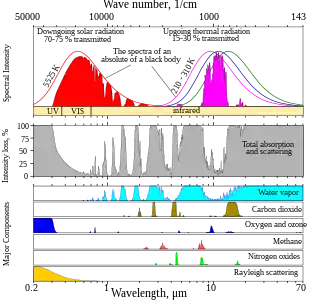Atmospheric window
An atmospheric window is a range of wavelengths of the electromagnetic spectrum that can pass through the earth's atmosphere. The optical, infrared and radio windows comprise the three main atmospheric windows.[1]

Nomenclature
Some sources, mainly the ones related to the study of the greenhouse effect, suggest a synonymity of the terms atmospheric window and infrared window, due to the fact that the earth's infrared emissions escape into space via this range of wavelengths (8 – 14 μm); in this context, the infrared window is examined as the atmosphere's sole escape route of heat, exclusively described as the atmospheric window.[2][3] This terminological ambiguity is not present in other fields of science and technology, namely radio astronomy[4] and remote sensing.[5]
Scientific importance
The atmospheric windows, especially the optical and infrared, play a vital role in the sustainability of life on Earth, regulating the earth-atmosphere energy balance.[6] They are utilised for observational and telecommunicational purposes and closely studied by environmental scientists.
In astronomy
Up until the 1940s, astronomers used optical telescopes to observe distant astronomical objects whose radiation reached the earth through the optical window. After that time, the development of radio telescopes gave rise to the more successful field of radio astronomy that is based on the analysis of observations made through the radio window.[7]
In telecommunications
Communications satellites greatly depend on the atmospheric windows for the transmission and reception of signals: the satellite-ground links are established at frequencies that fall within the spectra of atmospheric windows.[8][9]
In remote sensing
Both active (signal emitted by satellite or aircraft, reflection detected by sensor) and passive (reflection of sunlight detected by the sensor) remote sensing techniques work with wavelength ranges contained in the atmospheric windows' spectra.[10]
References
- "Introduction to the Electromagnetic Spectrum | Science Mission Directorate". science.nasa.gov. Retrieved 2021-12-28.
- Cotton, William R.; Pielke, Roger A. (2007). Human impacts on weather and climate. Cambridge: Cambridge University Press. p. 180. ISBN 978-0-521-84086-6. OCLC 466742997.
- Rohli, Robert V; Vega, Anthony J (2012). Climatology. Sudbury, MA: Jones & Bartlett Learning. p. 287. ISBN 978-0-7637-9101-8. OCLC 569552317.
- Burke, Bernard F. (2019). An introduction to radio astronomy. Cambridge: Cambridge University Press. p. 5. ISBN 978-1-107-18941-6. OCLC 1199628889.
- Joseph, George (2005). Fundamentals of remote sensing. Hyderabad: Universities Press, India. p. 43. ISBN 978-81-7371-535-8. OCLC 474734434.
- US Department of Commerce, NOAA. "The Earth-Atmosphere Energy Balance". www.weather.gov. Retrieved 2021-12-29.
- Wilson, Thomas (2016). Tools of Radio Astronomy. Springer-Verlag GmbH. pp. 1–2. ISBN 978-3-662-51732-1. OCLC 954868912.
- Banerjee, P. (2017). Satellite communication. New Delhi: Prentice-Hall of India. p. 181. ISBN 978-81-203-5299-5. OCLC 1223331096.
- Ngan, King N. (2001). Video Coding for Wireless Communication Systems. CRC Press. p. 183. ISBN 978-1-4822-9009-7. OCLC 1027783404.
- Dwivedi, Ravi Shankar (2017). Remote sensing of soils. Srpinger-Verlag GmbH. p. 13. ISBN 978-3-662-53738-1. OCLC 959595730.